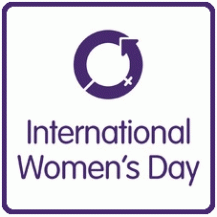This week’s topic: FAT TALK.
This week’s topic: FAT TALK.

While eating disorders are not specific to women, I think it is important to acknowledge International Women’s Day (IWD) as a source of strength and inspiration. If you follow IWD’d website you will find that there are many events offered within Canada.
(Here is a link starting close to today’s date to look for events)
Why is it important to me to celebrate IWD? It begs us to reflect on how far we have come and consider where we are now. Western culture can celebrate the liberated women given that our laws are fair, and judicially we are equal. Where are you in your life? How does you role as a women empower or disempower you today? Now this does not have to be a reflection of men’s influence, but how you perceive yourself because IWD is about equal treatment of both genders.
Here is a video that I found from the IWD 2013 archives:
This video is a bit lenghty, totally worth it, but I’ll summarize Jarrah Hodge’s points:
2 Areas to work on – Representation and Recognition…
I included video not because it is very specific to the my blog, but because it demonstrates distinct and subtle connections to eating disorders.
If we continue to be delimited by the images and ideas about roles that are less than our full potential, our self-value will also be held back. A woman who is faced with strong mentors will base their worth on ideals and overcoming challenges rather than diet and physical attractiveness.
I love IWD because it reminds us to overcome our fears and reach out to higher goals that breach superficial ideals.
If you’d like to hear more from Jarrah Hodge, follow her blog: Gender Focus.
 The subject of this week is Geneen Roth. She is an author and a mentor to thousands of women who attend her retreats and workshops, and who have read her books. Having struggled herself with weight gain and weight loss, losing and gaining over 1000 lbs since adolescence, Roth turned her life around to focus on what motivates compulsive eating. She has now publicized her studies to share her healing wisdom,
The subject of this week is Geneen Roth. She is an author and a mentor to thousands of women who attend her retreats and workshops, and who have read her books. Having struggled herself with weight gain and weight loss, losing and gaining over 1000 lbs since adolescence, Roth turned her life around to focus on what motivates compulsive eating. She has now publicized her studies to share her healing wisdom,
Her bestseller, Women, Food, and God: An Unexpected Path to Almost Everything is a must-read for any woman who lives with an inner critic that takes a toll on their her and happiness. Roth reveals that there is a link between what shows up on our plates to our beliefs about the amount of joys and strains in life that we deserve.
My mother presented this book to me two years ago, and as 19-year old without any religious values, I immediately felt dissuaded by the title. However, this book is far from religious. The concept of God that Roth presents is not specific to any organized religion, but as a spiritual place where healing, goodness, and love exist. God is a place where wholeness is achieved not by remedying our feelings and anxieties with temporary comfort, but by looking within ourselves and acknowledging where these feelings are coming from.
The rawness of this book is what it is important. In a world saturated with advertisements telling us that consumption is the path to happiness, Roth challenges her readers to face themselves. While she acknowledges that the path to wholeness can be difficult and scary, it is important to ask yourself: “do I want to continue to live like this.” Whatever kind of eating disorder you may face, she explains, the essential choice we must all make is self-love or self-judgment.
When and why we eat defines our attitude around food. Roth provides a set of seven guidelines to adhere to in order to redevelop a healthy relationship to the dinner plate:
1. Eat when you are hungry. (Truly hungry – body hungry, not mind hungry)
2. Eat sitting down in a calm environment. This does not include the car.

3. Eat without distractions. Distractions include radio, television, newspaper, books, intense or anxiety-producing conversation and music.
4. Eat only what your body wants. (Big difference from what your MIND wants!)
5. Eat until you are satisfied. (This is different than full).
6. Eat (with the intention of being) in full view of others.
7. Eat with enjoyment, gusto and pleasure.
These rules emphasize the importance of listening to your body and taking time to appreciate food.
Women, Food, and God is a #1 New York Times top seller and Roth has been invited to appear on various talk shows to discuss confronting compulsive eating since its release. Roth also hosts her own retreats and workshops in America. Women are invited to engage in their struggles personally with the guidance of Roth herself. Her clients learn to befriend themselves and identify what constructs exist in their lives that affect their eating patterns. If this is something you would be interested in, visit her website.
Who else is talking about this?
This week I’d like to do a commentary on a couple of workout images that came to my attention through the twitter feeds of some girls “getting ready” for Cancun. Although physical fitness is about strength and health, there are some that produce negative images. These images are usually dependent on feeding guilt, implying shame, or promising self-satisfaction through body change.
Subject A:

This image was released by a local gym. The idea promises trainers that if they give themselves 12 weeks they will reach what they want to become, but for who? This image implies that self-legitimation comes from the outside. To feel confident in yourself you must receive the attention of others. It is necessary to go to the gym, not to feel good, or become healthy, but to gain approval. On the flip side this indicates that it is necessary to change your body in order to reach that. Now how does this tie into eating disorders? Many disorders are bred by neglect or feeling unnoticed and unimportant, so people turn to changing their body to get attention.
Body modification is used as a surface treatment to treat deep, inner conflict. While activity has proven to raise level of endorphins and better your mood, it is important to be encouraged appropriately. People training should feel inspired to be strong, not that they have something to prove to others.
Subject B:
 Probably the more depressing of the two, once again focusing on the stomach, a sensitive area. Both these images draw importance to the abdominals, which take a lot of time and diet to become visible. You could have the strongest tummy in the world, but that protective layer of fat is a natural safeguard against famine that our ancestors’ genetics has programmed.
Probably the more depressing of the two, once again focusing on the stomach, a sensitive area. Both these images draw importance to the abdominals, which take a lot of time and diet to become visible. You could have the strongest tummy in the world, but that protective layer of fat is a natural safeguard against famine that our ancestors’ genetics has programmed.
But I digress, let’s talk about what this image is saying. It hits home by mentioning a commonly mediated stressor… going to the beach. As soon as the new year roles around, especially near the end of winter. Magazine stands are flooded with women’s magazines that preach about their miracle diets and workouts and slimming swimsuits to “get ready” to go to the beach. You might be trying to buy groceries, and “boom” some headline is guilting you to diet because you can’t possibly spend your leisure time at a beach until you are “ready”. That’s a lot pressure for something that should just be carefree and fun.
So this image is basically saying that if you’re not spending weeks at the gym before beach season rolls around, you’ll be covered up. In fact, it wants to you to think you should so that you’ll spend more money going to the gym. Surprise, this came from a newsfeed of another London gym. No one should be made to feel that they have to hide. Guilt and shame-inducing ideas like these feed the diet and fitness industry billions of dollars.
Don’t take these images at face value. It is important to recognize that the way they try to convey inspiration is not productive. Think about them critically instead of internalizing harmful ideals.